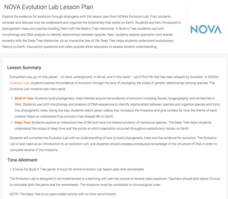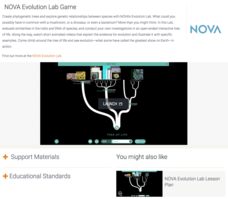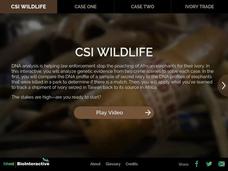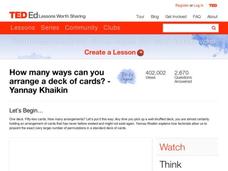Flipped Math
Calculus AB/BC - Determining Concavity of Functions over Their Domains
Time to take a second look at derivatives finding concavity. While watching the video, learners find out the definition of concavity. Individuals see how to determine whether an interval is concave up or concave down using graphs and the...
Flipped Math
Calculus AB/BC - Derivatives of tan(x), cot(x), sec(x), and csc(x)
Continue to differentiate the rest of the trigonometric functions. Pupils see the derivatives of the other four trigonometric functions and begin to memorize the rules. Learners see examples that show that the calculus portion of a...
Flipped Math
Calculus AB/BC - The Quotient Rule
Some differentiation rules are just better to memorize. The ninth lesson in a unit of 11 presents the quotient rule to pupils for them to memorize. Learners use the quotient rule to determine the derivative of two quotients after seeing...
Flipped Math
Calculus AB/BC - The Product Rule
There's more to derivatives of multiplication than simply the product of the derivatives. A helpful video gives learners the product rule of finding the derivative of the product of two functions. Pupils find the derivatives of functions...
Flipped Math
Calculus AB/BC - Derivatives of cos(x), sin(x), e^x, and ln(x)
The shortcuts are not just for polynomial functions. Pupils learn the derivatives of the two basic trigonometric functions, cosine and sine. The video provides the derivatives for exponential and logarithmic functions. Learners work...
Flipped Math
Calculus AB/BC - Connecting Differentiability and Continuity
Despite what you thought, you can differentiate between continuity and differentiability. Using a short lesson, pupils learn how differentiability and continuity relate to each other. It provides three descriptions of when a function is...
Flipped Math
Calculus AB/BC - Estimating Derivatives of a Function at a Point
It seems like it should be about three. Pupils learn to get an estimate of the derivative of a function at a point by using the derivative functionality of their graphing calculators. They take that information to determine the equation...
Flipped Math
Calculus AB/BC - Defining the Derivative of a Function and Using Derivative Notation
Pupils learn how to find the derivative of a function by applying the definition using limits. Learners understand that the derivative provides the slope of the tangent line and use that information to find the equation of the tangent...
Flipped Math
Calculus AB/BC - Average and Instantaneous Rate of Change
Ramp up the average rate of change—instantly. Learners use their knowledge of the formula to find the average rate of change to find the instantaneous rate of change. The presenter shows pupils an interactive that demonstrates finding...
Google
The White House
Taking a guided tour through the White House would require extensive travel costs and an armed security escort—but a virtual tour only requires an Internet connection! A few clicks bring users through the historical corridors and rooms...
iCivics
Tribal Government: High School
Did you know there are 567 federally recognized American Indian and Native Alaskan tribes and villages in the United States alone? The resource helps break down the complexities of many different tribal societies to explain the concept...
Federal Reserve Bank
Once Upon a Dime
The story of "Once Upon a Dime" starts like any other fairy tale, but it quickly becomes a story about the value of money and the economic system commonly used before it. Presented as a cartoon, the resource consists of dialogue between...
Physics Classroom
The L.O.S.T. Art of Image Description - Converging Lenses
Magnifying glasses and cameras often use converging lenses, but how do they alter an image? Pupils discover a lens, axis, and object arrow before identifying four characteristics of the resulting image. They label the location,...
Physics Classroom
Law Enforcement - Refraction
Pupils apply their knowledge of refraction to four different sets of challenges. Each of the first three focus on one variable's impact on the direction of bending. The fourth combines variables for greater challenge.
Physics Classroom
The L.O.S.T. Art of Image Description - Curved Mirrors
We see curved mirrors every day in spoons, rear-view mirrors, stores as a safety measure, make-up mirrors, and in novelty stores. Scholars explore the changes to an image based on the curve of the mirror, the location of the image, and...
Physics Classroom
Who Can See Who?
While only briefly mentioned in most Physics books, plane mirrors and their applications offer the basics necessary for future studies. While working through an interactive, pupils demonstrate knowledge of both reflection and its forms....
Physics Classroom
Law of Reflection
Reflection seems simple to understand, but without a complete understanding, pupils struggle with ray diagrams, specular versus diffuse reflection, total internal reflection, and image formation. An engaging interactive provides three...
CK-12 Foundation
Journalism 101
How do people express their rights of free expression through the press? Journalism 101 is the perfect combination of modules for 11th and 12th graders to learn about First Amendment rights, reporting and writing skills, digital...
PBS
NOVA Evolution Lab Lesson Plan
It doesn't matter if you look on land, in the air, underground, or in water—evolution is everywhere. Scholars complete worksheets with multiple question types as they progress through six online missions creating phylogenic trees.
PBS
NOVA Evolution Lab Game
Many scholars study phylogenetic trees without understanding how they are made. Through an online game, young scientists use the given data to create phylogenetic trees of increasing complexity. They rely on the trees they create to...
Howard Hughes Medical Institute
CSI Wildlife
Can DNA fingerprinting prevent the extinction of elephants? Young scientists learn about DNA fingerprinting before applying their knowledge to case studies of elephant poaching. The first case requires them to match the DNA from a tusk...
Whitman College
Virtual Fetal Pig Dissection
Pigs and humans have the same metabolism level and similar organs and systems, which is why they are often used in scientific laboratories. This worthy virtual dissection of a fetal pig divides into eight chapters: anatomical references,...
TED-Ed
How Many Ways Can You Arrange a Deck of Cards?
Entertain and grab your learners' attention with a short video clip that engagingly teaches the concept of a permutation and how a factorial is a wonderful shortcut for theoretical probability calculations.
Historical Thinking Matters
Spanish-American War: 5 Day Lesson
Nine historical documents, an interactive online notebook, and a fantastic opportunity for historical inquiry await your pupils in this 5-day lesson plan. Class members identify and discuss various causes for the Spanish-American War...

























